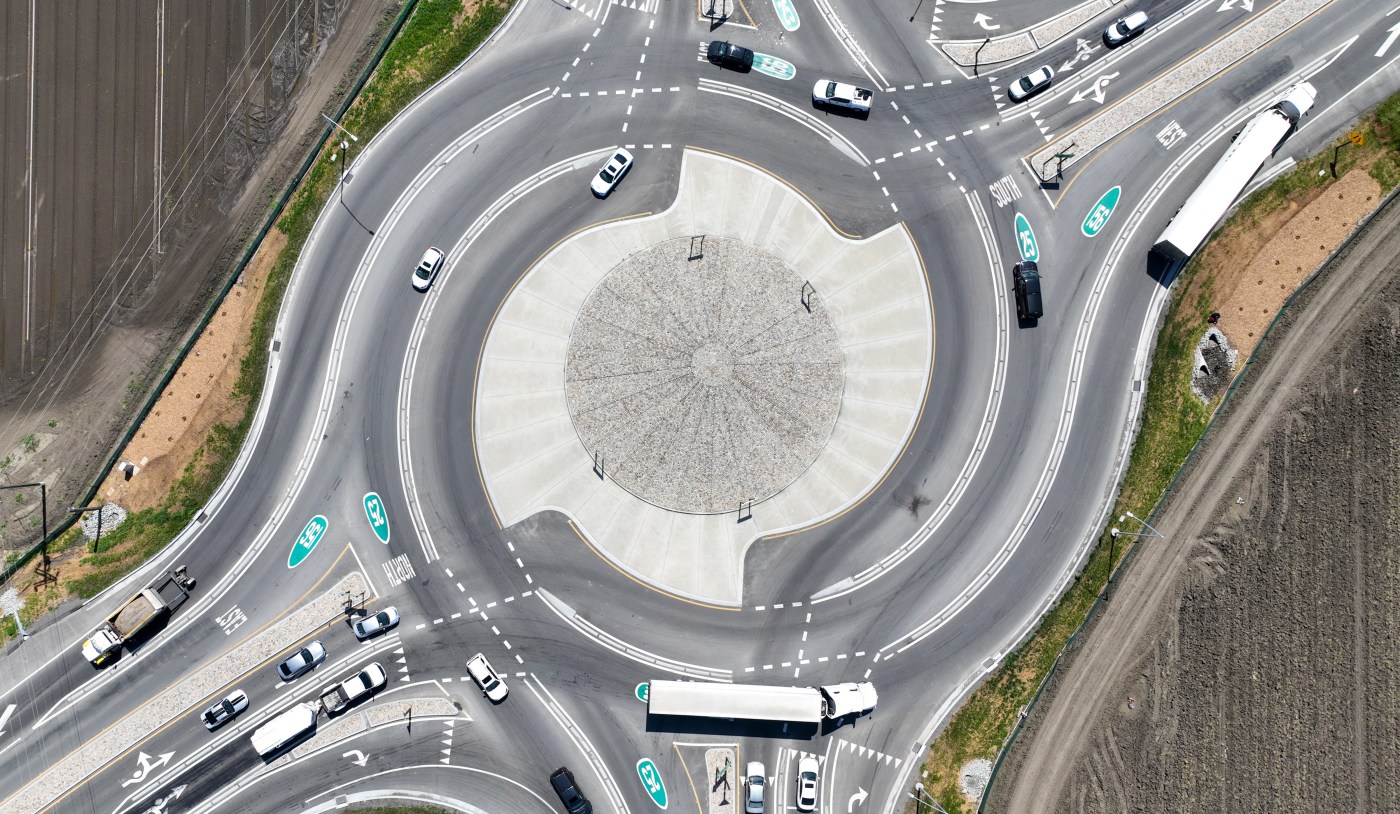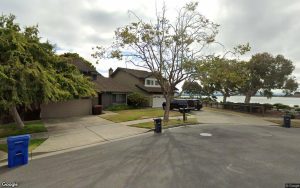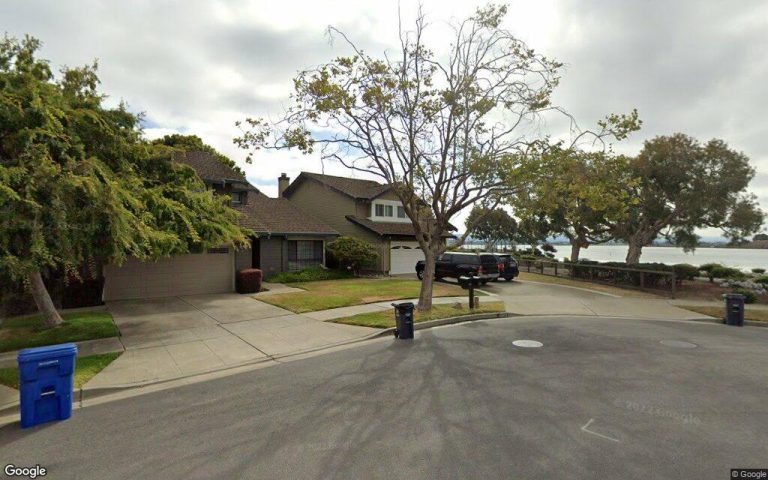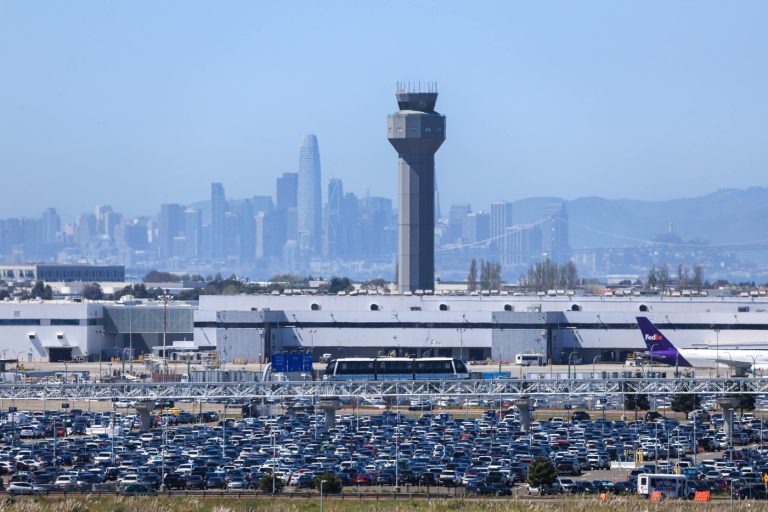HOLLISTER — When drivers first crossed this particular roadway in San Benito County last February, they encountered an intersection never before seen in California — a multi-lane “turbo roundabout” shaped like a cartoon hurricane.
And, while the turbo roundabout has a history of making intersections safer throughout Europe, here the Scandinavian rotary has led to confusion among some drivers who have been seen entering the intersection backward, hopping over lane dividers, and cutting through yield signs.
“I use the roundabout twice a day, and I definitely see some stuff,” said Wayne Wallace, who lives in Hollister and works in San Jose. The most common blunder he sees is drivers trying to shift lanes after entering the roundabout, jumping over the concrete divider meant to keep them in their lane. “I’ve seen people catching air jumping over it,” he said.
In one instance, Wallace witnessed a crash when a car cut over the divider in front of a semi, which hit it broadside.
Since Caltrans first unveiled the roundabout in February at the intersection of highways 25 and 156 near Hollister, the site has seen a significant spike in crashes, according to a Mercury News analysis of crash data from California Highway Patrol.
In the weeks following the opening of the roundabout, the intersection saw crashes at more than three times the rate than the year before it was built — jumping from about one accident approximately every eight days to one accident every two and a half days, on average.
Matea Rodriguez, who lives in Campbell and commutes every weekday to Hollister, said some roundabout regulars have grown impatient with befuddled motorists, speeding through the roundabout and engaging in “risky maneuvers.”
“People get jumbled up because they see someone just blow through (the roundabout) and everybody gets a little scared,” she said. Rodriguez also witnessed a crash when a driver did not yield to traffic within the roundabout, hitting the side of another vehicle.
“The data regarding San Benito County’s turbo roundabout are worrying,” said Vincenzo Gallelli, who studies road safety and roundabouts at the University of Calabria in Italy, noting that the “indecision of some drivers or the lack of prudence of others” could lead to collisions, especially given the novelty of the roundabout to American drivers.
But despite the spike in incidents, officials and experts said they are confident this is all part of a “learning curve” that often happens with new roundabouts, and point out that deaths and serious injuries have dropped to zero since the new intersection was completed.
Caltrans built the turbo roundabout because the stoplight that preceded it was not doing enough to control the flow of traffic in a notoriously dangerous spot — the site of over twice as many accidents as similar intersections in the state, with some resulting in serious injuries or death. In particular, an unusual number of rear-impact and T-bone collisions occurred there.
Crashes at the “turbo roundabout” are three times hight at the intersection of highways 25 and 156, in Gilroy, Calif., on Saturday, April 12, 2024. While there have been no fatalities or serious injuries, collisions have been happening at the rate of one every 2.5 days. (Shae Hammond/Bay Area News Group)
None of the crashes since the addition of the roundabout have been fatal or led to serious injury. And while around one in every two accidents led to injury before the turbo roundabout was installed, that number has dropped to one in four, according to a Mercury News analysis.
“I would say those are numbers that show the roundabout is proving to be a much safer environment than it was before,” said Jim Shivers, spokesperson for Caltrans District 5. “When you think about the thousands of people that travel through that roundabout each and every day, the high majority are doing so without incident.”
Before opting to build the roundabout, Caltrans previously attempted several small fixes, such as changing the timing on the traffic signals and adding rumble strips. After these failed to resolve the problems, the agency opted to create the special roundabout.
Related Articles
Pilot, dog escape plane that hit the water and sank off California coast
One dead, two injured following accident In East Bay
6 adults, child rescued from capsized boat in Tomales Bay
SFFD pull four people from water after boat capsizes near Ocean Beach
Two fire trucks hit by cars on Interstate 680 in Fremont, Walnut Creek
Since their invention in the Netherlands, turbo roundabouts have a proven track record of creating safer intersections that have fewer, less severe accidents, says Kakan Dey, who researches traffic safety at Michigan State University. “The roundabout is inherently safe because you need to slow down,” he said, noting that the safety has made the turbo roundabout relatively standard throughout Europe.
Studies in the Netherlands showed that the design advancements increased traffic capacity while reducing crashes by over 70% compared to traditional roundabouts.
The Scandinavian design includes extra features to prevent drivers from changing lanes while going through the intersection. Approaching drivers must choose their lane before entering the roundabout and follow overhead signage that shows which lane leads to which exit. Additionally, the Hollister rotary features lanes wide enough to accommodate semi-trucks and separated by raised, concrete dividers.
The project was completed in February and cost $10.9 million, funded by the State Highway Operation and Protection Program.
San Benito County public works administrator Steve Loupe acknowledges the unfamiliarity of the intersection. “I think for all of us, there’s a bit of a learning curve,” he said. “You’re making movements that a motorist is not used to making.”
Since the roundabout was new to drivers, Caltrans released educational videos in English and Spanish last year explaining how to use the intersection. Caltrans has also discussed potentially working on improved signage to help guide drivers, Loupe said.
However, the experts, officials, and even eye-witnesses agreed that the essential component to decrease crashes would be time.
Traffic safety researcher Dey says that studies of new roundabouts show a spike in crashes that gradually evens out over time. And while educational materials and signage may help, he says there is a difference between “learning” and “learning by doing.”
“The more people encounter (the turbo roundabout), the more they’ll understand it,” said Dey. “Eventually it will contribute to a safer intersection.”
Crashes at the “turbo roundabout” are three times hight at the intersection of highways 25 and 156, in Gilroy, Calif., on Saturday, April 12, 2024. While there have been no fatalities or serious injuries, collisions have been happening at the rate of one every 2.5 days. (Shae Hammond/Bay Area News Group)












